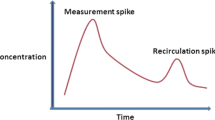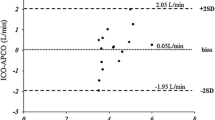Abstract
Objective
To compare the assessment of cardiac output (CO) in children using the noninvasive Ultrasound Cardiac Output Monitor (USCOM) with the invasive pulmonary artery catheter (PAC) thermodilution cardiac output measurement.
Design and setting
Prospective observational study in a tertiary center for pediatric cardiology of a university children's hospital.
Patients
Twenty-four pediatric patients with congenital heart disease without shunt undergoing cardiac catheterization under general anesthesia.
Measurements and results
CO was measured by USCOM using a suprasternal CO Doppler probe in children undergoing cardiac catheterization. USCOM data were compared to CO simultaneously measured by PAC thermodilution technique. Measurements were repeated three times within 5 min in each patient. A mean percentage error not exceeding 30% was defined as indicating clinical useful reliability of the USCOM. CO values measured by PAC ranged from 1.3 to 5.3 l/min (median 3.6 l/min). Bias and precision were −0.13 and 1.34 l/min, respectively. The mean percentage error of CO measurement by the USCOM compared to PAC thermodilution technique was 36.4% for USCOM.
Conclusions
Our preliminary data demonstrate that cardiac output measurement in children using the USCOM does not reliably represent absolute CO values as compared to PAC thermodilution. Further studies must evaluate the impact of incorporating effective aortic valve diameters on CO measurement using the USCOM.


Similar content being viewed by others
References
Egan JR, Festa M, Cole AD, Nunn GR, Gillis J, Winlaw DS (2005) Clinical assessment of cardiac performance in infants and children following cardiac surgery. Intensive Care Med 31:568–573
Webster CS, Merry AF, Emmens DJ, Van Cotthem IC, Holland RL (2003) A prospective clinical audit of central venous catheter use and complications in 1000 consecutive patients. Anaesth Intensive Care 31:80–86
Critchley LA, Peng ZY, Fok BS, Lee A, Phillips RA (2005) Testing the reliability of a new ultrasonic cardiac output monitor, by using aortic flowprobes in anesthetized dogs. Anesth Analg 100:748–753
Tan HL, Pinder M, Parsons R, Roberts B, van Heerden PV (2005) Clinical evaluation of USCOM ultrasonic cardiac output monitor in cardiac surgical patients in intensive care unit. Br J Anaesth 94:287–291
Chand R, Mehta Y, Trehan N (2006) Cardiac output estimation with a new Doppler device after off-pump coronary artery bypass surgery. J Cardiothorac Vasc Anesth 20:315–319
Knobloch K, Lichtenberg A, Winterhalter M, Rossner D, Pichlmaier M, Phillips R (2005) Non-invasive cardiac output determination by two-dimensional independent Doppler during and after cardiac surgery. Ann Thorac Surg 80:1479–1484
Chan JS, Segara D, Nair P (2006) Measurement of cardiac output with a noninvasive continuous wave Doppler device versus the pulmonary artery catheter: a comparative study. Crit Care Resusc 8:309–314
Knobloch K, Hubrich V, Rohmann P, Lupkemann M, Gerich T, Krettek C, Phillips R (2006) Feasibility of preclinical cardiac output and systemic vascular resistance in HEMS in thoracic pain-the ultrasonic cardiac output monitor. Air Med J 25:270–275
Knobloch K, Hoeltke V, Jakob E, Vogt PM, Phillips R (2007) Non-invasive ultrasonic cardiac output monitoring in exercise testing. Int J Cardiol 2007 (epub ahead of print: 26 April)
Siu CW, Tse HF, Lee K, Chan HW, Yung C, Lee S, Lau CP (2007) Cardiac resynchronization therapy optimization by ultrasonic cardiac output monitoring (USCOM) device. Pacing Clin Electrophysiol 30:50–55
Bland JM, Altman DG (1986) Statistical methods for assessing agreement between two methods of clinical measurements. Lancet I:307–310
Tibbals J, Hochmann M, Osborne A, Carter B (1992) Accuracy of the BoMED NCCOM3 bioimpedance cardiac output monitor during induced hypotension: an experimental study in dogs. Anaesth Intensive Care 20:326–331
Critchley LAH, Critchley JAJH (1999) A meta-analysis of studies using bias and precision statistics to compare cardiac output measurement techniques. J Clin Monit 15:85–91
Dey I, Sprivulis P (2004) Emergency physicians can reliably assess emergency department patient cardiac output using the USCOM continuous wave Doppler cardiac output monitor. Emerg Med Australas 17:193–199
Nidorf SM, Picard MH, Triulzi MO, Thomas JD, Newell J, King ME, Weyman AE (1992) New perspectives in the assessment of cardiac chamber dimensions during development and adulthood. J Am Coll Cardiol 19:983–988
Gardin JM, Tobis JM, Dabestani A, Smith C, Elkayam U, Castleman E, White D, Allfie A, Henry WL (1985) Superiority of two-dimensional measurement of aortic vessel diameter in Doppler echocardiographic estimates of left ventricular stroke volume. J Am Coll Cardiol 6:66–74
Nottermann DA, Castello FV, Steinberg C, Greenwald BM, O'Loughlin JE, Gold JP (1989) A comparison of thermodilution and pulsed Doppler cardiac output measurement in critically ill children. J Pediatr 115:554–560
Murdoch IA, Marsh MJ, Tibby SM, McLuckie A (1995) Continuous haemodynamic monitoring in children: use of transoesophageal Doppler. Acta Paediatr 84:761–764
Author information
Authors and Affiliations
Corresponding author
Additional information
All authors are members of the Working Group on Non-invasive Haemodynamic Monitoring in Paediatrics.
Rights and permissions
About this article
Cite this article
Knirsch, W., Kretschmar, O., Tomaske, M. et al. Cardiac output measurement in children: comparison of the Ultrasound Cardiac Output Monitor with thermodilution cardiac output measurement. Intensive Care Med 34, 1060–1064 (2008). https://doi.org/10.1007/s00134-008-1030-y
Received:
Accepted:
Published:
Issue Date:
DOI: https://doi.org/10.1007/s00134-008-1030-y




